Home >> What fungi are >> How fungi work
HOW FUNGi WORK
Although fungi may appear to be complex organisms their activities can usually be localized to a very particular part of their anatomy, the hyphal tip. Hyphae grow from the tip; you can visualize them as a rigid tubes having a soft and flexible ends.
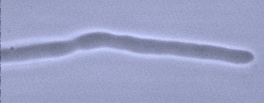 The interior of a hypha is filled with cytoplasm, the cell sap, that exerts pressure outward against the cell walls. As water is taken up, the pressure inside the hypha increases and the soft wall material at the hyphal tip stretches and extends forward. During growth, new wall material is added at the tip while the walls behind the tip become more inflexible. Thus the hypha extends through its environment like an endlessly inflating tubular balloon. Although the hyphal tip may appear soft, delicate and exposed to damage it is in fact a remarkably powerful device. Hyphal tips are able to penetrate solid materials like wood and leather that you might expect to be immune to microbial invasion
The interior of a hypha is filled with cytoplasm, the cell sap, that exerts pressure outward against the cell walls. As water is taken up, the pressure inside the hypha increases and the soft wall material at the hyphal tip stretches and extends forward. During growth, new wall material is added at the tip while the walls behind the tip become more inflexible. Thus the hypha extends through its environment like an endlessly inflating tubular balloon. Although the hyphal tip may appear soft, delicate and exposed to damage it is in fact a remarkably powerful device. Hyphal tips are able to penetrate solid materials like wood and leather that you might expect to be immune to microbial invasion
Hyphal penetration of solid materials may be accomplished by pressure alone but is usually accompanied by various sorts of chemical attack. As the hyphal tip pushes into its environment it releases substances that soften or even dissolve material in its path. This combination of hyphal tip growth and chemical release is the very essence of the fungal organism; everything else is secondary.
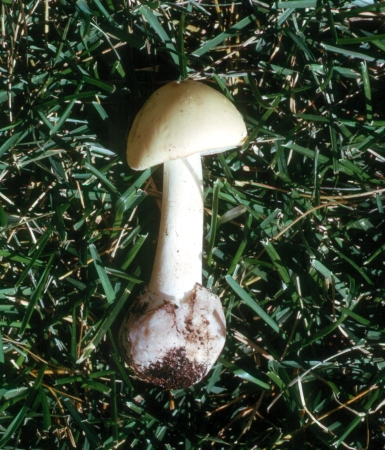
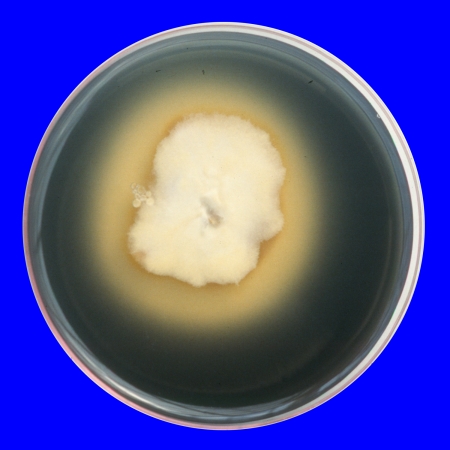
The picture above left is of Amanita citrina, a common inhabitant of mixed woods in our region. Although this mushroom might appear to be a whole plant-like organism it is actually just a spore-bearing structure produced by a much larger subterranean network of hyphae. The picture at right also illustrates Amanita citrina, but here it is shown growing in a Petri dish culture in the laboratory. To do this, one must partly fill the dish with a nutrient medium and cause it to gel by adding a substance called agar. When the medium has solidified, a small piece of flesh from inside the cap of the mushroom is placed on its surface and the dish is kept covered for several weeks. if the nutrients are acceptable to the fungus and if no competing organisms invade, a cottony growth of hyphae will develop. in this case the hyphae are pale yellow (citrine), similar to the colour of the mushroom cap. The nutrients in the medium are taken up by the hyphal tips and transported to all parts of the mycelium.
The picture of A. citrina growing in a Petri dish is interesting in other ways as well. When the medium was first prepared it was transparent, not black at the edges as it is in the picture. As part of its nutrient formula the fungus was given starch in a soluble form. This was done because some fungi can digest starch while others cannot and the experimentor was curious to know which group A. citrina belonged. You might think that the ability to grow with starch as a sole source of energy would be sufficient evidence to say starch was being digested but this researcher wanted further proof. To do this he waited until the hyphae had grown a few centimeters and then he flooded the dish with an iodine solution. it is well known that if iodine is mixed with starch the starch will become blue or black. in this case, if starch was still present in the medium it would turn black with iodine, and if it was not the medium would only turn a slight yellowish colour from the iodine alone, and this is what happened in the area surrounding the colony. Further away from the colony the medium is black, indicating that starch had not yet been digested.
Extracellular enzymes
The Petri dish has yet another lesson for us. You might be asking why the starch was digested in an area where the fungus had not yet grown. The answer to this question is that digestive enzymes were being released by the hyphal tips into the medium and these were diffusing out ahead of the fungus to break down the starch into glucose, a simple carbohydrate readily assimilated by the fungus for its nutritional needs. This act of digestion outside the cell and absorption of the breakdown products is called extracellular digestion and is accomplished through the action of extracellular enzymes. Virtually all fungi do this.
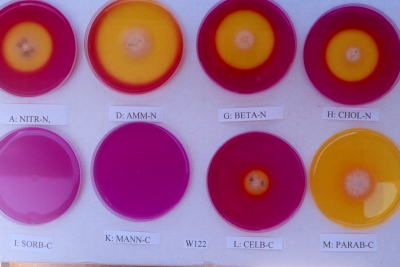
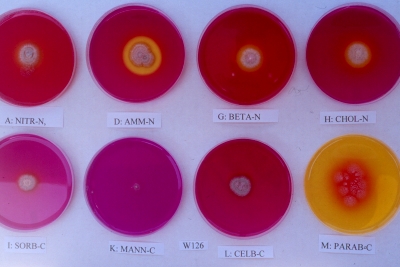
Although all fungi produce extracellular enzymes they do not produce the same ones. Each fungus produces a battery of such enzymes and each species has its own particular set. if you provide two species of fungi with identical sets of nutrient media they will display their individual "likes and dislikes". All fungi require carbon-containing substances such as sugars as sources of energy and all need nitrogen-containing substances to build proteins and other essential components. The above illustrations demonstrate these varied preferences in two species of Penicillium, here labelled "W122" and "W126". Both had been found on wild fruits in a hardwood forest. in the top row of Petri dishes each fungus is being grown on four souces of nitrogen: sodium nitrate, ammonium chloride, betaine and choline. in the bottom row are four sources of carbon: sorbitol, mannitol, cellobiose and parabenzoic acid. A purple indicator pigment was added to all of the media except the one with parabenzoic acid; if acid were to be produced during growth the pigment would turn from purple to yellow. The comparative responses of the two species can be assessed by their visible growth and by the size of the yellow acidified zone around them. For example, note that W122 was unable to grow at all with sorbitol as a source of carbon, while W126 did fairly well on it. Note also that W122 produced copious acid, probably citric or oxalic acid, as it grew while W126 produce very little in any of its dishes. Acid production is also extracellular and may play an important role in rendering certain nutrients soluble or in defense against other microorganisms. in some cases fungal acids can etch glass or rock and may cause serious deterioration of stone buildings and monuments.
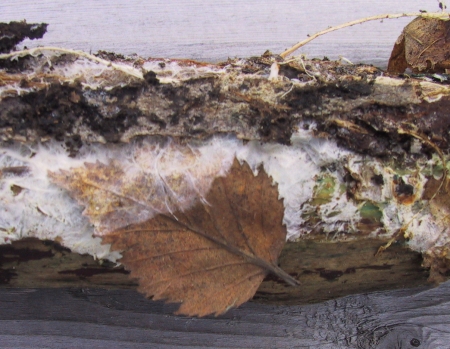
Equipped with individual suites of enzymes and acids fungi can become specialized for the digestion of almost any organic substance you can think of. There are fungi specializing in the digestion of fingernails, crude petrolium, dead insects, marine driftwood and all other pieces of the living world. Evidence for the digestion of such substances is readily seen in nature if you take the time to look. For example, the picture at right shows a mass of hyphae that was growing on a dead log when it encountered a dead birch leaf. it grew out on the surface of the birch leaf and began digesting it, bleaching the leaf in the process.
Beside extracellular enzymes and acids, hyphae also release alcohols and other simple organic substances as well as complex molecules such as antibiotics that repel or kill other microorganisms. They may also produce substances that are highly toxic to larger animals, including humans. These so-called mycotoxins are of major importance in the food industry where they must be scrupulously excluded.